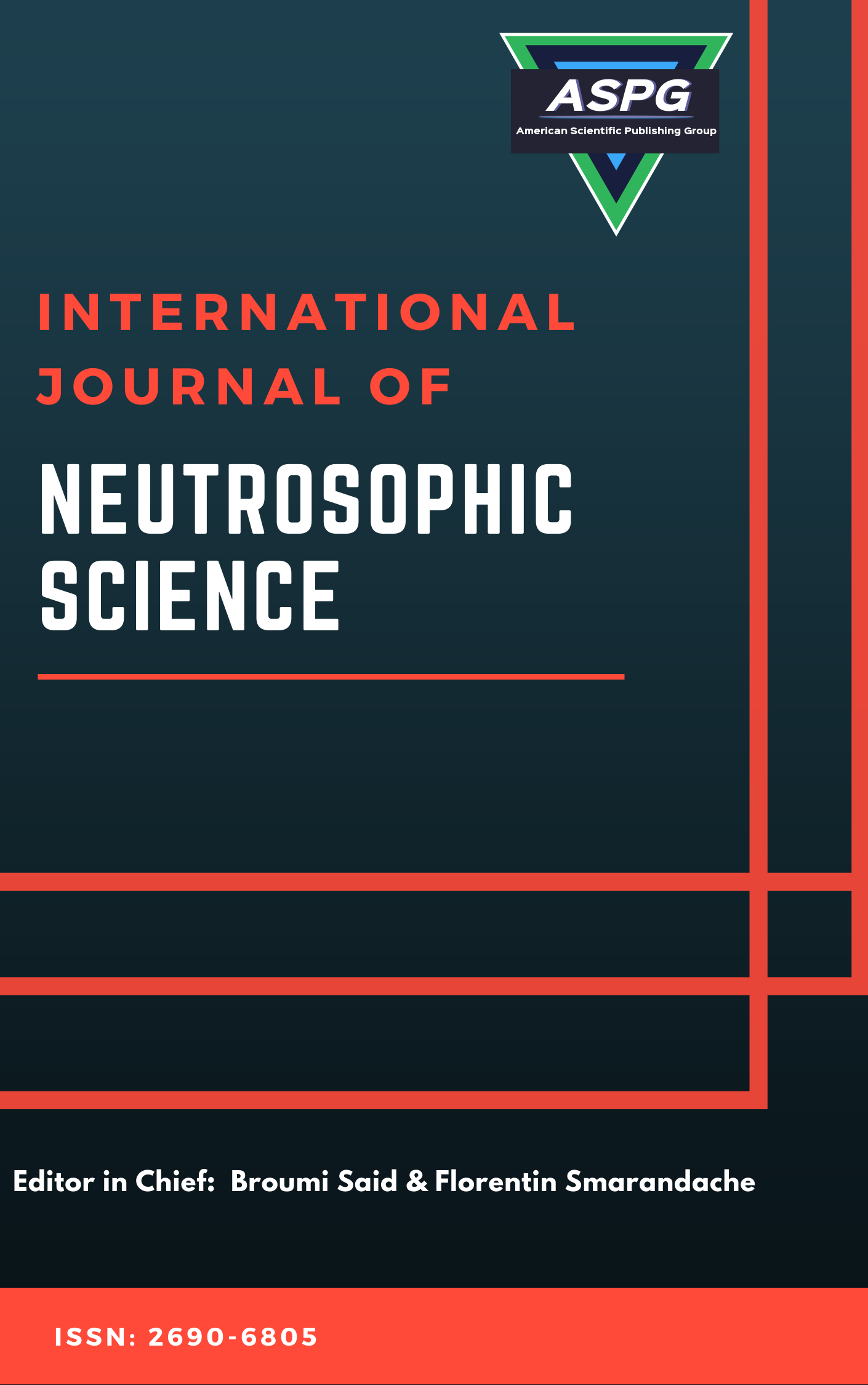

Volume 27 , Issue 2 , PP: 474-488, 2026 | Cite this article as | XML | Html | PDF | Full Length Article
Samandarboy Sulaymanov 1 * , Gafurov Ubaydullo Vakhabovich 2
Doi: https://doi.org/10.54216/IJNS.270238
We introduce a neutrosophic framework to assess corruption across micro, meso, and macro levels and illustrate it with a public, fully synthetic dataset covering five Central Asian societies (2020–2025). The framework models the proposition “High Corruption” with three independent degrees: Truth (T ), Indeterminacy (I), and Falsity (F), which need not sum to one. We propose a summary index—the Neutrosophic Evidence Risk Index (NERI)—that couples evidence for and against high corruption with indeterminacy. Empirically, we document three stylized patterns in the synthetic data: (i) a moderate decline in country-level NERI over time for most countries; (ii) a negative association between region-year e-service adoption and bribe solicitation; and (iii) a negative association between digital government capacity and T at the country-year level. For example, the average bribe-solicitation rate is 0.047 overall, 0.198 without e-services (95% CI 0.175–0.220) vs. 0.019 with e-services (95% CI 0.015–0.022), implying a risk difference of -0.179 and a relative risk of 0.094.
Neutrosophic Sets , Neutrosophic Logic , Indeterminacy , Uncertainty Quantification , Multilevel Modeling , Corruption Assessment , Governance , Central Asia , Public Sector Integrity , E-Government , Decision Support Systems , Transition Economies , Social Measurement , Institutional Analysis , Neutrosophic Sociology
[1] M. E. A. Tapia, M. M. Cabrita, D. F. Coka Flores, and C. G. Rodr´ıguez Tapia, “Neutrosociology for An- alyzing Public Procurement in Ecuador around the Health Emergency,” Neutrosophic Sets and Systems, vol. 44, 2021.
[2] A. Khudaykulov, “The relationship between economics and international regulatory affairs in transition economies and neutrosophic sets: A Review,” International Journal of Neutrosophic Science, vol. 21, no. 3, 2023. DOI: https://doi.org/10.54216/IJNS.210306
[3] A. Zafar and M. A. Wajid, “Neutrosophic Cognitive Maps for Situation Analysis,” Neutrosophic Sets and Systems, vol. 29, 2019. DOI: https://doi.org/10.5281/zenodo.3514407
[4] B. D. N. Montenegro, O. F. S. Montoya, J. R. S. Andrade, and C. F. T. Odar, “Neutrosophic Analysis of Equity in the Justice System,” Neutrosophic Sets and Systems, vol. 62, 2023. DOI: https://doi.org/10.5281/zenodo.10436957
[5] S. Aydin and M. Y¨or¨uko˘glu, “Turkish ground handling services firms assessment with neutrosophic multiobjective method,” Journal of Intelligent and Fuzzy Systems, vol. 38, no. 1, 2020. DOI: https: //doi.org/10.3233/JIFS-179428
[6] M. Karamustafa and S. C¸ ebi, “A new model for the occupational health and safety risk assessment pro- cess: Neutrosophic FMEA,” Journal of the Faculty of Engineering and Architecture of Gazi University, vol. 38, no. 1, 2023. DOI: https://doi.org/10.17341/gazimmfd.976297
[7] M. Aslam, “Neutrosophic analysis of variance: application to university students,” Complex and Intelli- gent Systems, vol. 5, no. 4, 2019. DOI: https://doi.org/10.1007/s40747-019-0107-2
[8] A. AlAita and H. Talebi, “Exact neutrosophic analysis of missing value in augmented randomized com- plete block design,” Complex and Intelligent Systems, vol. 10, no. 1, 2024. DOI: https://doi.org/10.1007/s40747-023-01182-5
[9] M. Yasir, A. Zafar, and M. A. Wajid, “NEP-2020’s Implementation & Execution: A Study Conducted Using Neutrosophic PESTEL Analysis,” International Journal of Neutrosophic Science, vol. 20, no. 2, 2023. DOI: https://doi.org/10.54216/IJNS.200207
[10] M. Aslam, “Analyzing wind power data using analysis of means under neutrosophic statistics,” Soft Computing, vol. 25, no. 10, 2021. DOI: https://doi.org/10.1007/s00500-021-05661-0
[11] M. B. Zeina and M. Abobala, “On The Refined Neutrosophic Real Analysis Based on Refined Neu- trosophic Algebraic AH-Isometry,” Neutrosophic Sets and Systems, vol. 54, 2023. DOI: https: //doi.org/10.5281/zenodo.7817744
[12] A. AlAita and M. Aslam, “Analysis of covariance under neutrosophic statistics,” Journal of Statis- tical Computation and Simulation, vol. 93, no. 3, 2023. DOI: https://doi.org/10.1080/ 00949655.2022.2108423
[13] M. Abdel-Basset, M. Mohamed, and F. Smarandache, “An extension of neutrosophic AHP-SWOT analysis for strategic planning and decision-making,” Symmetry, vol. 10, no. 4, 2018. DOI: https: //doi.org/10.3390/sym10040116
[14] X. Peng and J. Dai, “A bibliometric analysis of neutrosophic set: two decades review from 1998 to 2017,” Artificial Intelligence Review, vol. 53, no. 1, 2020. DOI: https://doi.org/10.1007/ s10462-018-9652-0
[15] F. Smarandache, New Types of Neutrosophic Set/Logic/Probability, Neutrosophic Over-/Under-/Off-Set, Neutrosophic Refined Set, and their Extension to Plithogenic Set/Logic/Probability, with Applications. MDPI, 2020. DOI: https://doi.org/10.3390/books978-3-03921-939-1
[16] U. Rivieccio, “Neutrosophic Logics: Prospects and Problems,” Fuzzy Sets and Systems, vol. 159, no. 14, pp. 1860–1871, 2008. DOI: https://doi.org/10.1016/j.fss.2007.11.011
[17] D. K. Kadali, R. N. V. J. Mohan, and M. C. Naik, “Enhancing Crime Cluster Reliability Using Neutro- sophic Logic and a Three-Stage Model,” Journal of Engineering Science and Technology Review, vol. 16, no. 4, 2023. DOI: https://doi.org/10.25103/jestr.164.05
[18] A. A. Abduvaliev, A. A. Isadjanov, U. A. Dadabaev, and M. E. Balbaa, “Neutrosophic Framework for Analyzing Factors of Innovation in the Development of Uzbekistan: Features and Modern Tendencies,” International Journal of Neutrosophic Science, vol. 21, no. 3, pp. 34–46, 2023. DOI: https://doi.org/10.54216/IJNS.210303
[19] A. Usmanova, “The Impact of Economic Growth and Fiscal Policy on Poverty Rate in Uzbekistan: Ap- plication of Neutrosophic Theory and Time Series Approaches,” International Journal of Neutrosophic Science, vol. 21, no. 2, pp. 107–117, 2023. DOI: https://doi.org/10.54216/IJNS.210210
[20] S. Aydın, C. Kahraman, and M. Kabak, “Decision making for energy investments by using neutrosophic present worth analysis with interval-valued parameters,” Engineering Applications of Artificial Intelli- gence, vol. 92, 2020. DOI: https://doi.org/10.1016/j.engappai.2020.103639
[21] E. Altan and Z. Is¸ık, “Digital twins in lean construction: a neutrosophic AHP – BOCR analysis approach,” Engineering, Construction and Architectural Management, vol. 31, no. 12, 2024. DOI:https://doi.org/10.1108/ECAM-11-2022-1115